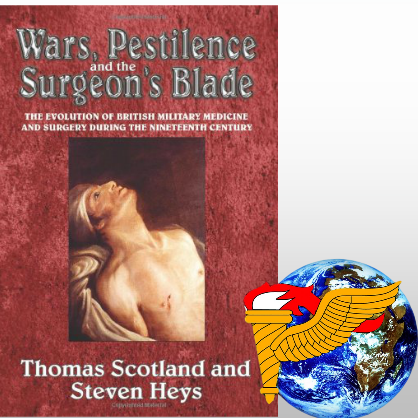The shout from the virtual War History Online office of ‘Who wants a book on Military Medicine?’ fell initially on deaf ears. It’s a specialist subject and not what I’d call a light read on a hot Sunday afternoon. Now, the kind of logic that shoehorned me into The Royal Army Medical Corps, kicking and screaming, during a stint in the TA, because I work for the NHS I must be medically trained was also applied in the handing out of this book. Mark Barnes, our much loved, overworked and underpaid
Reviews Editor decided that this book would benefit from my opinion. In that dark mass of a memory of his, I was something to do with healthcare. That’s like saying I’m an astronaut because I’ve watched 2001 A Space Odyssey (you failed to mention this on your job application – R.Ed).So, whilst orbiting the Earth in my role as a NASA space scientist I began to read.
The book covers the period from Wellington’s Peninsular War and Waterloo to the Second Boer War and the Russo-Japanese War at the turn of the twentieth century. It covers in great detail all the major advancements in battlefield medicine from first aid to the hospital aftercare and surgery where a soldier’s life was quite literally hanging from a thread, often before the first shots were even fired. One thing that continued to appall me were the casualty figures of soldiers who died from disease before actually fighting.
One example are the figures from the British Legion who fought in the Carlist Wars in Spain, a bloody and costly civil war. Out of around 9600 British men who went to fight just under 500 were killed in action, around 250 died of their wounds but a staggering 2000 died from disease. This was mainland Spain in the 1830’s – a terrible and shocking statistic.
When you begin to look at the death rate amongst soldiers, especially those on campaign, one really does wonder why they took the King’s shilling. The sad fact is that life in 19th Century working Britain was a terrible struggle. People lived life on a knife-edge and every sunrise was looked on as a bonus. The army, rightly or wrongly proved to be an escape from the poverty stricken slums of our celebrated great cities. London, Edinburgh, and Belfast being among the worst. Some saw the red jacketed soldiers in all their splendour as a chance for heroism and adventure. Realistically for many others it was a chance of clothes, food and a bed. Join the expanding Empire or die of hunger where you were born. Life, it would seem, was just as harsh in the army. You’d die of disease just the same, but hundreds or thousands of miles away from loved ones and often with no grave.
The book has a strange mixture of period photographs, portraits, maps, copies of well known oil paintings and lithographs and even anatomical drawings. All this plus the numerous charts, graphs and casualty figures for each conflict adds to the somewhat confused nature of the book. Its a very chaotic way in which to present information, as interesting as the subject matter is, it is mind boggling and sometimes frenzied. Whilst at work (My real NHS role, not he NASA one) I have picked up the occasional copy of The Lancet or The British Medical Journal, normally on the basis that the cover photograph has caught my eye, a sketch or painting that leads me to read and article about shell shocked victims in WW1 or Archibald McIndoe’s Guinea Pig Club for example. The theme so it would seem for medical journals is a bit like a doctor’s handwriting on a prescription; it’s hard to decipher.
The intensity of this book, however, takes on a whole new level though. I don’t pretend to be Einstein but at times I found it difficult to keep my concentration whilst reading certain parts. I also found the choice of battles or conflicts to be a little random. The subheading of the book reads British Military Medicine so apart from a handful of English or Scottish doctors volunteering in the far flung reaches of the world, I find it hard to understand why the reader has been taken to the Gettsyburg or is bogged down with the political beginnings of the Franco-Prussian War. But as with most things in the 19th century, like it or not, Britain and her Empire led the way, albeit at the cost of thousands of lives.
This book is expertly written (Scotland being an orthopedic surgeon and Heys is an expert on cancer surgery and having served in the RAMC). But the question I had to ask myself was is this book of interest to the casual military buff like myself.
The answer is yes, if you’re a medical student as well.
If you have the space in your bookcase and the money to spare there no doubt you will enjoy and gain valuable information from this book. If, like me however, you’re on a modest budget, a trip to your local library would probably suffice. Just make sure you remember to take the book back on time. Preferably before going into space!
Review by Phil Hodges for War History Online
WARS, PESTILENCE AND THE SURGEON’S BLADE
The Evolution of British Military Medicine and Surgery During The Nineteenth Century.
By Thomas Scotland and Steven Heys.
Helion & Company Ltd.
ISBN 978-1-909384-09-5
